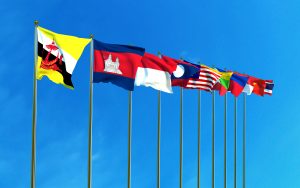Earlier this month, Southeast Asian countries and key dialogue partners convened a first-of-its-kind defense meeting on managing chemical, biological and radiological (CBR) threats. The meeting, long in the works and held under the banner of the ASEAN Defense Ministers’ Meeting (ADMM), highlighted ongoing efforts by key nations to continue to make inroads on the issue, despite a cascade of other regional and global security-related challenges.
While ASEAN has not experienced any major CBR attacks to date, it has not been entirely immune from the threat that non-state actors might use CBR agents. In Indonesia, for example, details have been publicized previously on foiled terrorist plots, the most recent of which was a 2019 attempt by members of the Islamic State-affiliated Jamaat Ansharud Daulah. This involved the use of explosives filled with the potent poison abrin, discovered as part of a series of arrests across the country following the stabbing of the-then chief security minister Wiranto. Given the waves of terrorism that Southeast Asia has previously experienced, some ASEAN countries have attempted to strengthen the region’s CBR approach over the past few years through various means, both intraregionally as well as with external partners.
A key development in this respect was when the regional grouping established a network of ASEAN CBR Defense Experts, an idea advanced by Singapore and subsequently approved by the ADMM during Singapore’s ASEAN chairmanship in 2018. Since then, the Network of ASEAN CBR Defense Experts has organized a range of engagements to strengthen CBR cooperation among ASEAN member states, and has attempted to build ties with other external partners and international organizations. These have included a table-top exercise on chemical incident response with Thailand, a technical seminar on biosafety and biosecurity with the Philippines, and trainings with the Organization for the Prohibition of Chemical Weapons and the International Atomic Energy Agency.
Earlier this month, ASEAN’s CBR approach was in the spotlight with the holding of the first-ever meeting of its kind on the subject under the ADMM-Plus, the highest-level defense consultative and cooperation mechanism within ASEAN, which groups Southeast Asian countries with eight dialogue partners – Australia, China, India, Japan, New Zealand, Russia, South Korea, and the United States. The ADMM-Plus CBR Conference, which has been under discussion for years within ASEAN as part of the region’s wider approach to the issue set, took place on October 11-12 in a hybrid format at the Shangri-La Hotel in Singapore, featuring CBR experts from the ADMM-Plus countries as well as other actors including international organizations.
The conference comprised of a series of engagements and covered a full range of topics, including CBR threat detection and response, and the use of new technologies to address CBR threats, with presentations by experts from countries including Australia, India, Japan, South Korea, and the United States. In-person attendees also had the opportunity to visit the Chemical, Biological, Radiological and Explosives (CBRE) Defense Group to witness a demonstration of the Singapore Armed Forces (SAF)’s CBR capabilities, which, as per Singapore’s defense ministry, included incident response, casualty management, on-site demonstration and forward deployment of chemical and biological testing by scientists from DSO National Laboratories, which currently serves as the Secretariat for the Network of ASEAN CBR Defense Experts.
The holding of this ADMM-Plus CBR Conference is not without significance. If held regularly and paired with proper follow-through, engagements of this type can play an important role in helping foster cooperation between various actors that are key to being prepared for an actual incident, including reaching agreement on common protocols and holding joint drills. They can also build the connective tissue necessary to bring together country, regional, and global actors as well as different communities – including the scientific, health, academic and security domains – to ensure a multi-level and multi-stakeholder approach. As the United Nations Under-Secretary-General and High Representative for Disarmament Affairs Izumi Nakamitsu emphasized in her keynote remarks to the conference, efforts by international organizations like the U.N. “are not sufficient” and need to be paired with other actors as well, including multilateral groupings like ASEAN.
To be sure, forging such a holistic approach, as the theme of the conference advocated, is not without its challenges. CBR is one of a wide range of threats faced by Southeast Asian states that have differing equities and diverse approaches, and thus it requires constant focus and agility to keep it on the agenda. Close observers would note, for example, that it took years for the idea of the conference to actually become a reality, and the CBR agenda has had to adjust to account for developments along the way, including COVID-19. The extent of progress will also be contingent upon engagement between ASEAN and its dialogue partners, a declared regional priority which is still in the works, along with the idea that it may expand beyond the existing group of partners which have made this part of their own agenda for working with Southeast Asia, including the European Union and the United States. This can then further catalyze some of the areas around CBR defense, including information sharing and capability building.
Yet given the serious implications of potential CBR attacks and the cross-border linkages forged by terrorist actors, regional cooperation is an urgent imperative to enhance preparedness within this dimension of security within Southeast Asia. As the most forward-leaning Southeast Asian countries in this realm recognize, that in turn will require not just incremental and selective cooperation among Southeast Asian states and their partners, but a truly interdisciplinary, multi-stakeholder, and cross-regional approach that is robustly advanced and sustained over time in a complex geopolitical environment.

































